In September of 1906, Selkirk ratepayers voted in favour of allowing its municipal government to borrow up to $150,000 to install a waterworks and sewer system for the town.
The waterworks would distribute a pressurized, filtered water supply to a network of businesses, homes, and fire hydrants. Prior to this, residents relied on their own wells or paid a ‘water wagon’ to deliver it to them.
The most noticeable feature of the waterworks was a 275,000-litre tank that stood 32 metres above the ground. Elevated tanks were seen as superior to ground level reservoirs because, in the case of a power outage or mechanical failure, gravity would keep the network fed (albeit at a much reduced pressure level).
The Town of Selkirk awarded tenders for the digging of trenches and laying of pipes in December 1906 and it appears to have taken a number of years to complete. There are no digitized archives from those years to track the progress, so the exact dates and years of the project are uncertain. There was, however, a waterworks committee that met regularly during that time who would report on the progress every meeting.
The Canadian Fairbanks Company and Minneapolis Steel and Machine Co. supplied the pumping equipment and engines, while the William Newman Company of Winnipeg (an engineering and construction company) built the pump house and made the final hook-ups.
Water was drawn from an aquifer 70 metres below ground using gasoline powered engines that pumped up to 450,000 litres a day. The water was filtered and pumped up the tower to the tank. For more information on how the system worked, here is a detailed description of the Moose Jaw system installed by the same companies in 1911.
In July 1910 enough of the system was in service that the high pressure fire hydrants were tested at a stable fire on Morris Avenue. In a matter of minutes, the blaze was out.
A report from Selkirk in the Winnipeg Tribune on November 2, 1910 noted that the full system went into operation in September and, at the time the story was published, it was nearly ready to be handed over to the Wm. Newman Co. for final inspection.
The origins of the old tank are a mystery. Available editions of Selkirk newspapers and engineering journals of the day do not mention who won that tender.
It’s likely that it was a Horton Tank from Chicago Bridge and Iron Works, a leading manufacturer of large water tanks at the time (the manufacturer would later create a Canadian subsidiary called Horton Steel Works at Fort Erie, Ontario in 1913). When the same companies teamed up to build Moose Jaw’s waterworks in 1911, it was built with a Horton tank.
A more local possibility was a company called Dominion Bridge of Montreal, which had a subsidiary in Winnipeg.
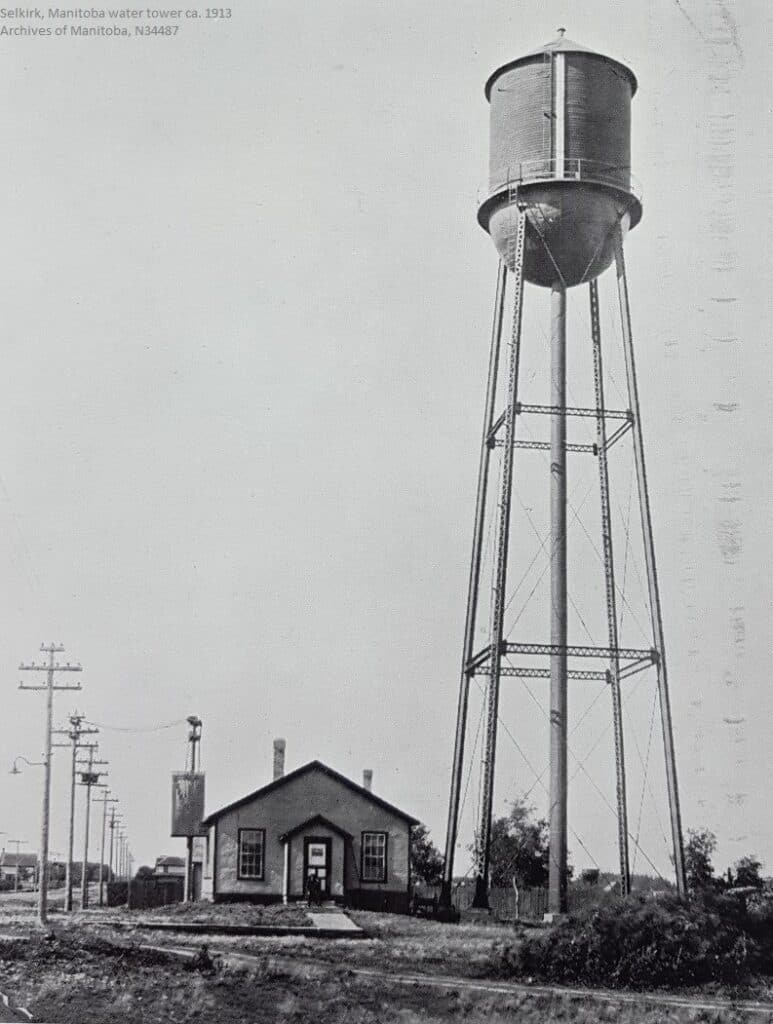
Providing Service
On November 1, 1910, Selkirk town council approved the fees it would charge waterworks customers. It was more expensive than Winnipeg’s water, but cheaper than Brandon’s and Portage la Prairie’s.
Homeowners could choose a flat rate service of $6 per year for a single water tap. An example given for more complicated set-ups was an eight-room house with indoor toilet and kitchen using both sewer and water. The flat rate for that home worked out to about $24 a year. Meters could be installed if it was felt that water use might be excessive, such as a property with large gardens, or below average, such as a seasonal home.
In the end, the waterworks cost the town about $75,000. The Winnipeg Tribune pointed out that thanks to its deep limestone aquifer, Selkirk had some of the best municipal water you could find in the province.
Tune Up
In 1927, the tower required some maintenance, which included a new paint job.
The tender for scraping and painting the tank was issued to Mr. Kenworthy and Mr. Allison late that year. They got the go ahead to start the maintenance at town council meeting on May 14, 1928, and had completed the job by May 29 of the same year.
Charles Taylor, Selkirk’s engineer, appeared before council at the end of May seeking additional payments for the men who had to spend time removing a large amount of mud that had settled at the bottom of the tank, and for enduring the exceedingly bad fumes while painting its interior. They received an extra $20 for their trouble. The total paid to them was $100.
On November 11, 1928, while the water tower was undergoing repairs, a fire began in the insulation inside the casing for the tower’s standpipe. Since the fire was impossible to reach, the fire brigade kept the pipe’s exterior as cool as possible. The main pipe and the wooden casing that held it in place were destroyed. The town was without water until later that day, when a makeshift pipe allowed water to start flowing again.

Joe Balcaen of Winnipeg was called in to make the repairs and install a new standpipe. The work was completed by the end of November 1928.
Another major repair came in 1937, when the base of the tank was replaced due to corrosion.
The tower was again repainted in May 1949 by Dougal Pruden. He was paid $575. The new paint job included two coats of paint on the tower structure and one coat for the tank.
New Tower
In the 1950s, it became obvious that the tower had to be replaced due to its age, and to the growing demand for water, which was related to the post-war housing and baby booms.
Dominion Bridge was called out in late 1958 to examine the structure. They determined that the tank was close to failure and noted that the workers accidentally put their hammer through the fragile outer skin in a couple of places. It was estimated that the tank had about eighteen months of functional life left.
Town council again decided on an elevated tank, this one with a capacity of 950,000 litres. The new tower and its necessary support buildings would be located roughly 30 metres north of where the existing tower stood on Mclean Avenue near Jemima Street.
At a town council meeting on February 27, 1961, it was announced that Horton Steel Works of Fort Erie, Ontario’s bid of $109,980 won the tender. Harris Construction was awarded the main contract for the construction of both the foundation and the waterworks building.
The new water tower would be a Horton Watersphere. The Watershpere was a patented design introduced by the company in the late 1940s was superior over more basic water tower designs. The support beam, access ladder, and standpipe were all enclosed to keep them protected from the elements. Its curved design meant that there were no exposed corners or welds for dirt and debris to cling to.
These operational factors and its ‘graceful, sweeping lines’ made the Watersphere popular for towns and industrial sites alike. Hundreds of the structures in various sizes were erected around North America from the 1950s through 1970s. Other Canadian examples of the Watersphere are located in Yorkton, Sault Ste. Marie, and Red Deer.
The companies wasted little time starting the project. By the middle of March 1961, Harris was already at work and Horton’s derricks had arrived on-site.
Harris’ first job was to sink 13 reinforced concrete cassion’s that were 70 centimetres in diameter to a depth of nearly 8 metres. The work was completed by mid-April, after which the concrete pad for the new tower was poured.
Once the cassion’s and concrete pad were finished, it was Horton’s turn to erect the Watersphere. The structure (which is now the current model of the Selkirk Water Tower) stands 40 metres in height, with the sphere itself about 13 metres tall by 15 metres wide.
There was an unexplained delay in the construction that required Horton to inform town council in July that it would not be able to complete the tower until August 18, 1961. It noted that the delay would not impact the opening date as the lost time could be made up in the filling and testing stages.

Before filling it, Horton painted the tower. City promotional material of the day referred to the colour as ‘lime green’ while the Selkirk Enterprise called it ‘bilious green’. It bore the name SELKIRK in bold, black letters.
It’s unclear when the tower officially opened, as it either was not mentioned in the local paper or that edition is not available online.
Once the new tower was in service, the old one was dismantled. The first step was to remove the town’s emergency siren from its top, which was used to signal members of the volunteer fire department from Selkirk and surrounding areas.
On November 22, 1963, an Environment Canada weather station was set up on the site of the old tower. Prior to that date, Selkirk’s weather information was taken from Winnipeg stations. The site now appears to be residential property.
The Watersphere has had five paint jobs since its installation in the 1960s.
Horton Steel Works came back in August 1966 to drain the sphere and repaint the tower, both inside and out. It’s unclear why this had to be done so soon after it was originally painted. The Selkirk Enterprise noted that it was done with a ‘special paint’ in the same shade of green.
The Watersphere was painted silver in 1978.
The Tower As We Know It
The blue and red striped paint job was done in 1998 by Western Industrial Services of Winnipeg.
In 2021, the City of Selkirk launched a design competition for the water towers newest paint job. It was won by Robyn Kacperski, a graphic designer born and raised in Selkirk. The new paint job was completed December 2021.
Selkirk Water Tower Collection

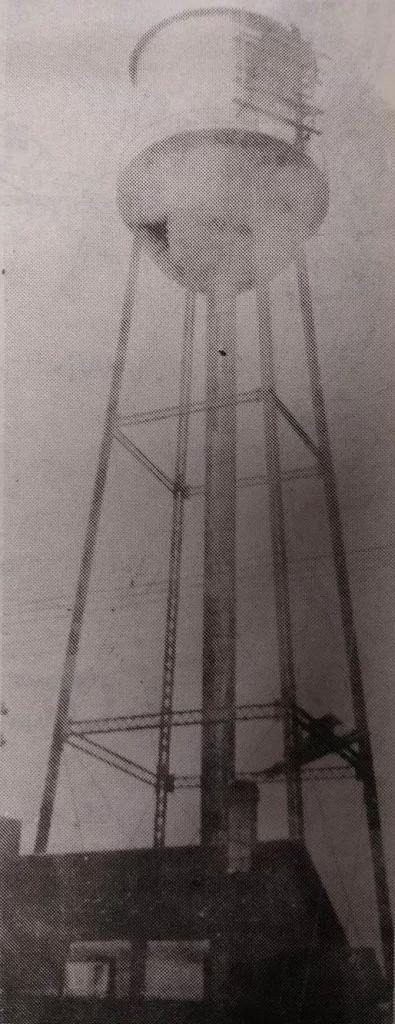

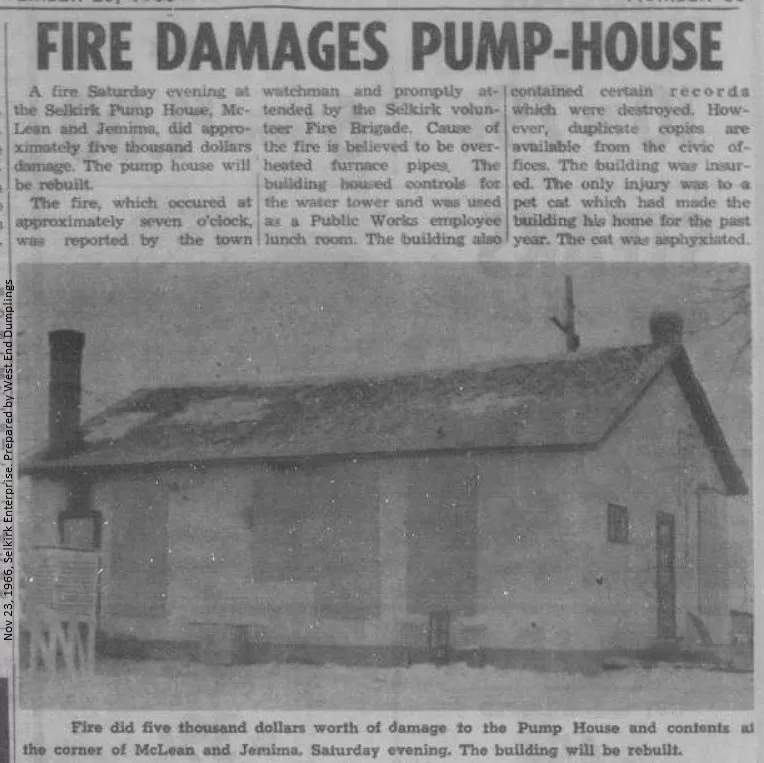
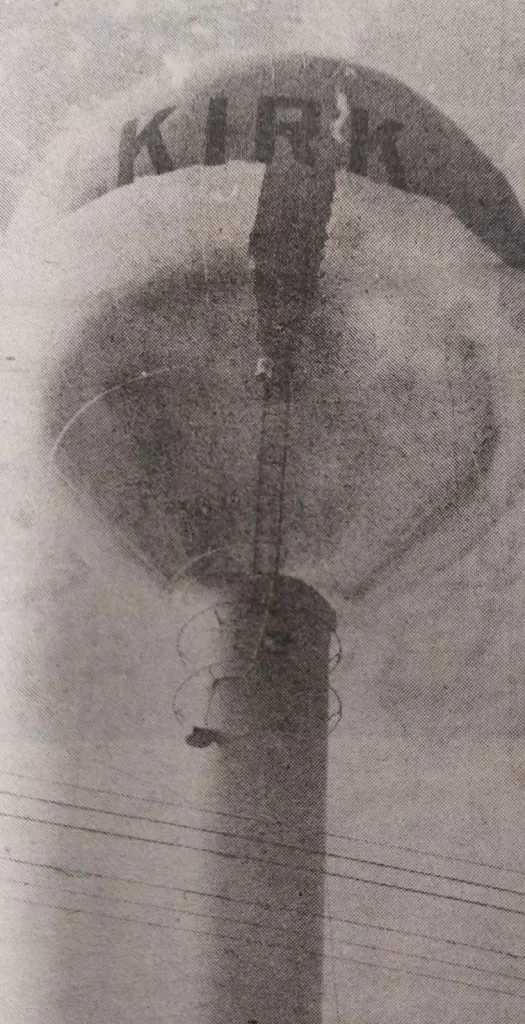

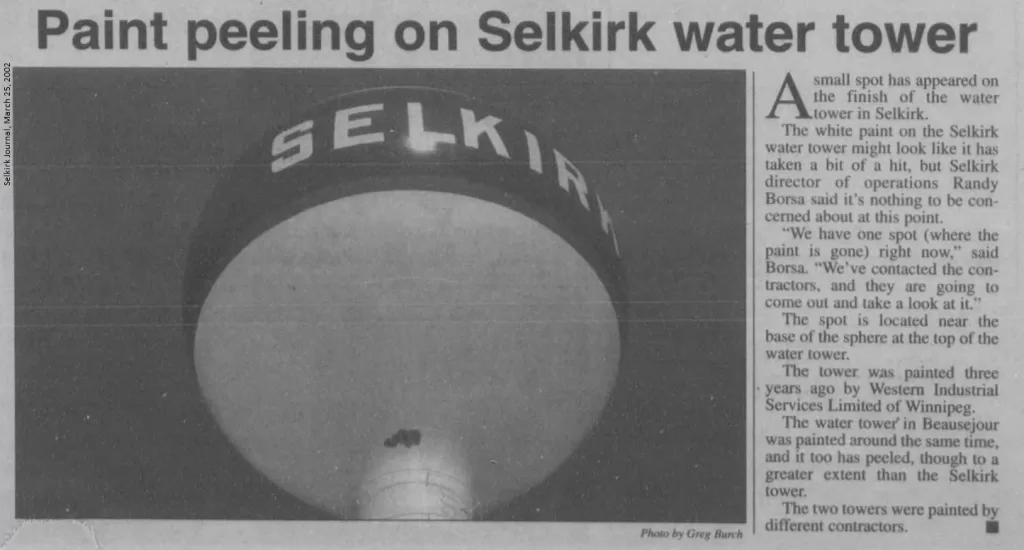
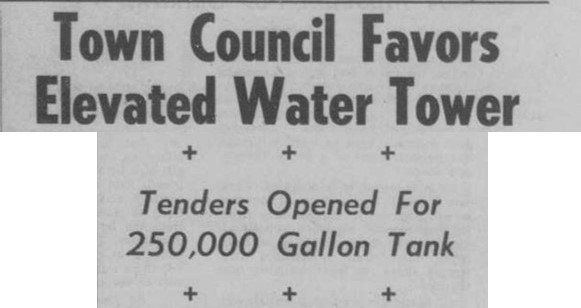
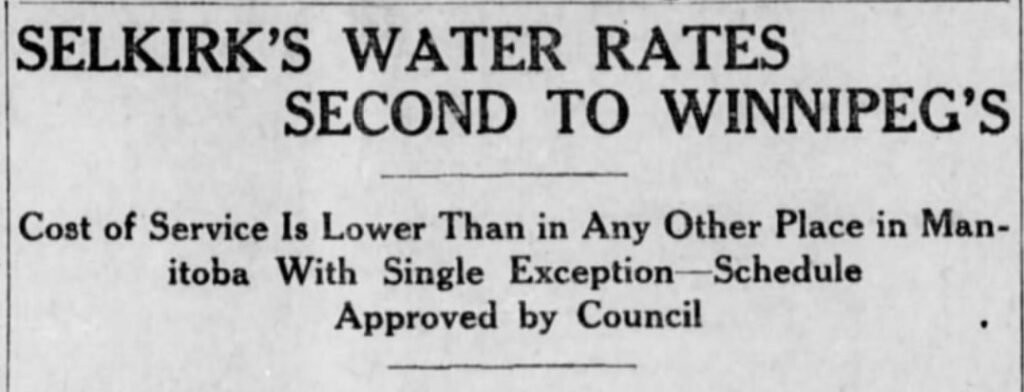
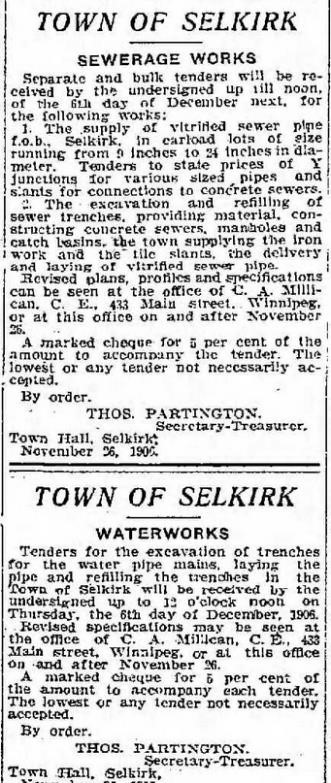


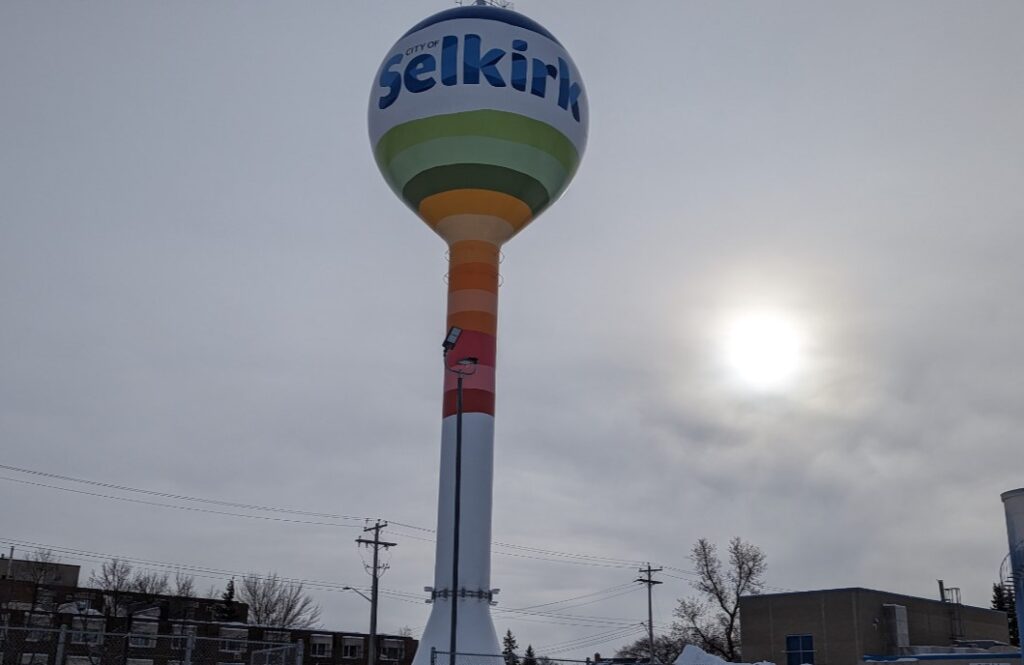
Sources
Archives of Manitoba
Selkirk Enterprise 1961, 1966, 1982
Selkirk Journal 1998, 2002
Winnipeg Free Press 1906
Winnipeg Tribune 1906, 1910

